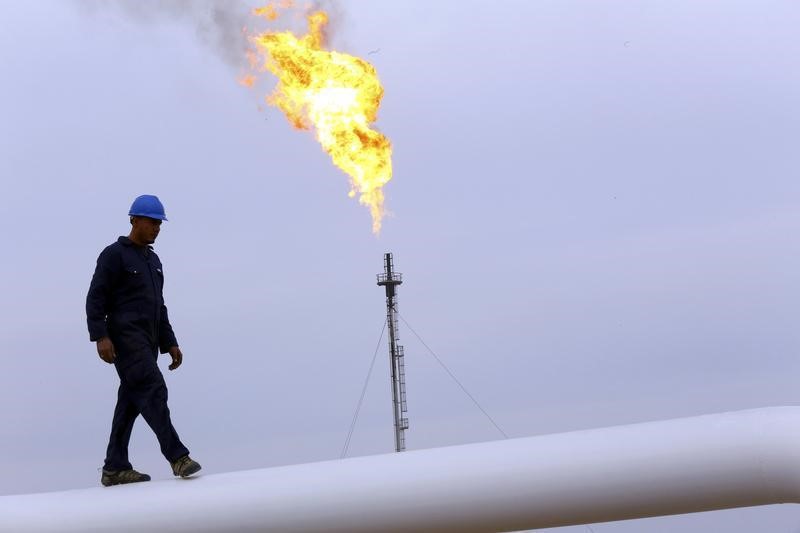Commodities
Oil jumps 7% on week as rally restarts on OPEC threat of more cuts


© Reuters.
Investing.com – As OPEC, you just have to say it, and worry about doing it later, or not doing it at all. But the market will respond, as you want it to, and that’s all that matters.
Crude prices hit 7-month highs on Friday, jumping as much as 7% on the week, responding to growing market conviction that Saudi Arabia will extend in October its voluntary monthly production cut of one million barrels per day introduced in July.
Adding to that was data showing better-than-expected U.S. jobs growth in August despite a rise in unemployment, with the Labor Department reporting 187,000 new versus a forecast 170,000 and a jobless rate of 3.8% from July’s 3.5%. The jobs numbers, at the least, “signal interest rates may not rise any further”, something all risk assets seemed to take positively, said Craig Erlam, analyst at online trading platform OANDA.
On the oil production front, the Saudis hinted at the October cut a month ago, saying they could even be deeper than before if warranted — a threat ostensibly aimed at short-sellers who might try to take prices down. While they have yet to make it official, the Russians, who happen to be the Saudis’ main ally in the OPEC+ group of 23-oil producing countries, did both their sides a favor this week by saying more “actions” were coming in the way of the oil market.
The Russian disclosure came after data on Wednesday showed U.S. crude stockpiles tumbling a third week in a row as refiners ramped up fuel processing to meet demand ahead of Monday’s Labor Day holiday — which marks the last hurrah for summer travel each year.
With two days of back-to-back gains of 2% or more, New York-traded West Texas Intermediate, or , crude settled Friday’s trade at $85.55 per barrel. For the day itself, it gained $1.92, or 2.3%, after Thursday’s 2.5 climb%. Week-to-date, the U.S. crude benchmark finished up 7.2%. That was after a combined 4% drop over two prior weeks as the economy in top importer China sputtered. Prior to that, WTI gained 20% over seven weeks.
London-traded settled at $88.55 per barrel, up $1.72, or 2%. For the week, Brent rose 4.8%. That was after a combined 2.3% drop over two weeks. Prior to that, the global crude benchmark rose for seven weeks in a row, gaining a total of 18%.
Oil rally resumes in earnest but seasonal lows in demand also coming
With the oil rally having resumed earnestly, the upside in crude prices could last in the interim with OPEC likely to make more rumblings to try and get Brent to the Saudis’ cherished target of $90 or more.
But with U.S. road travel seen easing hereafter and the oil market typically entering a seasonal low in demand during the fall season starting Sept. 23, the market could start feeling heavy without a commensurate downside adjustment.
“Demand is always a bigger proponent than supply and eventually it’ll show if it’s weak,” said John Kilduff, partner at New York energy hedge fund Again Capital. “China is still not buying enough and Iran is exporting more and more oil to to challenge the hyped up tight supply picture that’s hijacked the market narrative now.”
Reuters, using secondary sources on oil production, estimated that output within the narrower OPEC, or the 13-member Organization of the Petroleum Exporting Countries led by Saudi Arabia, had climbed by 220,000 barrels per day — thanks to a jump in Iranian output.
Iran is a founding member of the six-decade old OPEC that is essentially treated as an outcast within the cartel due to Trump-era sanctions on its oil exports. Once a major burden to its economy, the sanctions mean little these days to Tehran, thanks to little enforcement by the Biden administration. Iran’s crude production and exports have both been growing steadily the past two years to the consternation of the Saudis and Russians, who jointly steer OPEC+, the broader alliance of oil producers consisting of 23 countries.
(Peter Nurse and Ambar Warrick contributed to this item.)
Commodities
Oil prices rise; U.S. crude inventories plunge, Russia-Ukraine truce eyed
Commodities
India’s Reliance to stop buying Venezuelan oil over US tariffs, sources say
Commodities
Oil prices climb on Venezuela supply worries

 Forex3 years ago
Forex3 years agoForex Today: the dollar is gaining strength amid gloomy sentiment at the start of the Fed’s week

 Forex3 years ago
Forex3 years agoUnbiased review of Pocket Option broker

 Forex3 years ago
Forex3 years agoDollar to pound sterling exchange rate today: Pound plummeted to its lowest since 1985

 Forex3 years ago
Forex3 years agoHow is the Australian dollar doing today?

 Cryptocurrency3 years ago
Cryptocurrency3 years agoWhat happened in the crypto market – current events today

 World3 years ago
World3 years agoWhy are modern video games an art form?

 Commodities3 years ago
Commodities3 years agoCopper continues to fall in price on expectations of lower demand in China

 Economy3 years ago
Economy3 years agoCrude oil tankers double in price due to EU anti-Russian sanctions























